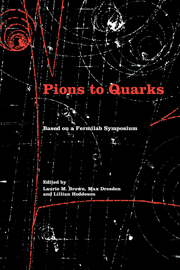Book contents
- Frontmatter
- Contents
- List of contributors
- Foreword by Leon M. Lederman
- Editors' acknowledgments
- Photographs of the symposium
- List of abbreviations
- List of notation
- I Introduction
- II Particle discoveries in cosmic rays
- III High-energy nuclear physics
- IV The new laboratory
- 9 The making of an accelerator physicist
- 10 Accelerator design and construction in the 1950s
- 11 Early history of the Cosmotron and AGS at Brookhaven
- 12 Panel on accelerators and detectors in the 1950s
- 13 Accelerators and the Midwestern Universities Research Association in the 1950s
- 14 Bubbles, sparks, and the postwar laboratory
- 15 Development of the discharge (spark) chamber in Japan in the 1950s
- 16 Early work at the Bevatron: a personal account
- 17 The discovery of the antiproton
- 18 On the antiproton discovery
- V The strange particles
- VI Weak interactions
- VII Weak interactions and parity nonconservation
- VIII The particle physics community
- IX Theories of hadrons
- X Personal overviews
- Name index
- Subject index
11 - Early history of the Cosmotron and AGS at Brookhaven
Published online by Cambridge University Press: 07 May 2010
- Frontmatter
- Contents
- List of contributors
- Foreword by Leon M. Lederman
- Editors' acknowledgments
- Photographs of the symposium
- List of abbreviations
- List of notation
- I Introduction
- II Particle discoveries in cosmic rays
- III High-energy nuclear physics
- IV The new laboratory
- 9 The making of an accelerator physicist
- 10 Accelerator design and construction in the 1950s
- 11 Early history of the Cosmotron and AGS at Brookhaven
- 12 Panel on accelerators and detectors in the 1950s
- 13 Accelerators and the Midwestern Universities Research Association in the 1950s
- 14 Bubbles, sparks, and the postwar laboratory
- 15 Development of the discharge (spark) chamber in Japan in the 1950s
- 16 Early work at the Bevatron: a personal account
- 17 The discovery of the antiproton
- 18 On the antiproton discovery
- V The strange particles
- VI Weak interactions
- VII Weak interactions and parity nonconservation
- VIII The particle physics community
- IX Theories of hadrons
- X Personal overviews
- Name index
- Subject index
Summary
In 1946, before the Atomic Energy Commission (AEC) could be formed, the Manhattan Engineering District established Brookhaven National Laboratory, a laboratory devoted exclusively to peacetime research. The mission was to make available in the Northeast certain facilities that were too large to be supported by any single university. Specifically, these facilities were
a nuclear reactor for research with neutrons,
a 700-MeV synchrocyclotron, and
a particle accelerator to reach or surpass the then-unheard-of energy of a billion electron volts (proton-synchrotron).
The reactor was, I think, the first built purely for scientific research purposes; it was decommissioned some years ago and replaced by a more modern reactor, which is still operating. The building of the cyclotron was given up after a year or so of design work; instead, the Nevis synchrocyclotron (somewhat smaller) was built by Columbia University.
As for the proton-synchrotron: Edwin McMillan and Vladimir I. Veksler had independently discovered the principle of phase stability, which was first applied to the synchrocyclotron and the electron-ring synchrotron. But for really high energy, the synchrocyclotron would become too massive to be attractive, since it requires the entire interior of the top energy orbit to be filled with magnetic field. The electron-synchrotron requires magnetic field only at the other radius and thus is more economical, but the phenomenon now known as synchrotron radiation made for very large power requirements at high energy. These requirements seemed to limit the energy to some 300 MeV (a rather elastic limit, which has since increased considerably, but really only by applying massive radio-frequency power).
- Type
- Chapter
- Information
- Pions to QuarksParticle Physics in the 1950s, pp. 180 - 184Publisher: Cambridge University PressPrint publication year: 1989



